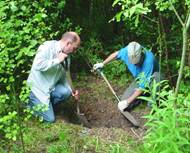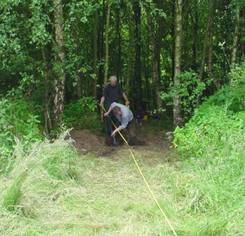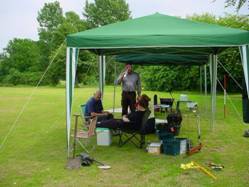
Our Big Dig site at Amberswood Common is well underway and by the time you get this
newsletter we should know if we have discovered the Roman Road. Our first visit on the 8th
June was a wet affair but despite persistent rain, we did manage to establish datum lines
and some test bore-holes with the augur. A week last Sunday, however, the weather was
perfect and we opened up a number of test pits along our datum line. What we discovered
however was not exactly what we expected. The assumption was that whole of this area site
had been used as a dumping ground for pit waste in the 19th century. From the many
bore-holes we sampled we could not find any evidence of this and in general the subsoil
seems to be very dry, consisting mainly of gritty sandy soil over a bed of light grey
sandy clay.

Test Pits
In our first test pit in the central area of our site we immediately hit a bank of
sandy clay just below the surface. The texture was different and more yellowy orange in
colour than the bore-hole clay so we suspect it was not natural. In test Pit 2 just to the
south of the first we immediately hit black soil filled will rubble. We decided to extend
this pit this rubble feature turned out to be a large ditch almost a metre deep filled
with rubble and cinder. All pottery recovered was no older than Victorian. However right
at the bottom, large cobbles began to appear embedded in denser clay, which seamed to
disappear into the sandy clay bank from the first pit. Could this be the base of the Road?
Test pit 3 was positioned further south from 2 and produced sandy black soil over a bed of
sandy clay. Further test pit to the south of this produced similar results.
We therefore decided to open another test pit to the north of our first to see if we could
find the extent of the bank of sandy clay. Before starting this we ran the resistivity
meter along the line of our datum to see if we could pick up any anomalies. On the edge of
the wood there was a sudden rise in resistivity so our final test pit went in here.
Unfortunately the anomaly fail to appear so we will have to wait until this weekend for
the final verdict.

On Tuesday last week Sharon Saunders of the Parks and Gardens department came to view
our progress. She was so impressed she has promised to provide us with a small excavator
so that we can open other trenches to the west of our present line. This will enable us to
establish if the ditch we found in pit 2 is a linear feature or just a local pit.
By the way the gazebos we bought have proved a big success providing a relaxing area for
tired-out archaeologists. A big surprise has been the interest from the local community as
well as the public in general. Mark has set up an information board and I have spent more
time conducting tours of the site than digging. (One lady even wanted to touch the cobble
surface of what we had described as being the Roman Road.)
Next Meeting
Wednesday 2nd July at the BP Centre (Scout HQ) in Greenough Street, at 7.30 pm as
usual. The speaker this month is our resident Egyptologist John Johnson
who will be talking about Egypt in the Pre-Dynastic period. Hope to see
you there.
Atherton Developments
Work has begun on a site in Atherton by a team from Manchester University. Initial
results are very encouraging and the team very confident the site will reveal significant
finds from a range of period (even Roman). I will reveal more in the next newsletter. B.A. |



